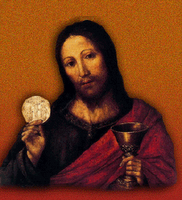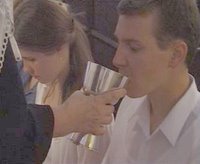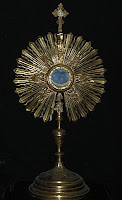Leftover Communion Elements
Q: Just wanted to let you know that your “Ask the Pastor” is great! You’ve already answered many questions that I’ve had but didn’t want to ask. A question that I have is what is the proper way of disposing the wine from the cup after Holy Communion? Is it proper to just pour it down the drain or should it be taken outside and poured on the grass? Keep up the good work!
 A: Thank you for your interest and your question. When the Lord’s Supper is regularly celebrated, disposal of “leftovers” can be a major concern. This is especially true in churches that understand Christ’s words, “This is My body ... this is my blood,” to mean that in some mysterious, God-caused manner, the body and blood of Christ are really and actually present. Yet even among those who view Communion as strictly a memorial, the solemnity of the circumstances makes them leery of merely dumping wine down the drain.
A: Thank you for your interest and your question. When the Lord’s Supper is regularly celebrated, disposal of “leftovers” can be a major concern. This is especially true in churches that understand Christ’s words, “This is My body ... this is my blood,” to mean that in some mysterious, God-caused manner, the body and blood of Christ are really and actually present. Yet even among those who view Communion as strictly a memorial, the solemnity of the circumstances makes them leery of merely dumping wine down the drain.If you use individual cups, some consider it proper to decant the contents of unused glasses into the original bottle or, better, pour it into one specially reserved for the remnant. The same can be done with the flagon (pitcher) used with the chalice (common cup).
 The question usually turns on what to do when the chalice is still half-full after all have communed. Certainly, we don’t want to pour back what’s been passed from mouth to mouth in the congregation. Respect for our Lord and His Supper keeps most of us from wanting to dump it down the drain to mingle with the sewage.
The question usually turns on what to do when the chalice is still half-full after all have communed. Certainly, we don’t want to pour back what’s been passed from mouth to mouth in the congregation. Respect for our Lord and His Supper keeps most of us from wanting to dump it down the drain to mingle with the sewage.Some congregations choose a cultivated area outside the building, such as a garden or a row of shrubbery. They treat this as a special place for receiving of the remnants of the Supper and will pour the wine out, perhaps with a prayer of thanks to the Lord who gives Himself in the Eucharist. Some churches go further and have a direct pipe from the church into the ground. Called a piscina (pronounced pih-SEE-nuh), nothing but the remaining communion wine or baptismal water is poured into it.
 In my mind, the best alternative has the pastor and any communion assistants waiting until after the service, then drinking what remains. Again, this is done in a respectful manner. This also follows Christ’s bidding to “drink.”
In my mind, the best alternative has the pastor and any communion assistants waiting until after the service, then drinking what remains. Again, this is done in a respectful manner. This also follows Christ’s bidding to “drink.”While you haven’t asked about the consecrated bread — the body of our Lord — remaining after all have communed, we should also consider it. Some will scoop what remains on the paten (plate) into a pyx or ciborium (communion ware dedicated to holding the bread until distribution). There it will be held until the next service. Others place the consecrated hosts back into the same container as the supply of unconsecrated bread. I also read and hear about churches that dump it on the grounds for the birds or who give what remains to the children.
 Catholicism normally holds the consecrated bread in a tabernacle, a box dedicated solely to that purpose. The sanctuary lamps or eternal flames common in many Christian churches these days actually come from the Catholic practice of lighting a special candle to signify to the priests and worshipers that consecrated bread remains. When the light is burning, many will bow or genuflect in the direction of the tabernacle. Additionally, one host is often withheld and placed on display in monstrance or ostensorium.
Catholicism normally holds the consecrated bread in a tabernacle, a box dedicated solely to that purpose. The sanctuary lamps or eternal flames common in many Christian churches these days actually come from the Catholic practice of lighting a special candle to signify to the priests and worshipers that consecrated bread remains. When the light is burning, many will bow or genuflect in the direction of the tabernacle. Additionally, one host is often withheld and placed on display in monstrance or ostensorium.Again, as I consider Jesus’ words, I can’t get past “eat ... drink.” Where does God tell us to store, display, or venerate? The Sacrament of the Altar “is the true body and blood of our Lord Jesus Christ under the bread and wine, instituted by Christ Himself for us Christians to eat and to drink. (Small Catechism)” Paul wrote, “As often as you eat this bread and drink the cup, you proclaim the Lord’s death until he comes. (1 Corinthians 11:26)” Eat and drink, eat and drink, eat and drink — we should be getting familiar with the pattern by now.
 Furthermore, I think that we do well to consider the Old Testament roots of the Eucharist. Christ intentionally chose the Passover as the meal upon which to base the New Testament of His body and blood. One of God’s commands for eating the Passover was that the lamb must be entirely consumed or destroyed: “The Lord said to Moses and Aaron in the land of Egypt ... ‘You shall let none of it remain until the morning; anything that remains until the morning you shall burn ... it shall be eaten in one house; you shall not take any of the flesh outside the house. (Exodus 12:1, 10, 46)” See also Exodus 34:25; Numbers 9:12; Deuteronomy 16:4.
Furthermore, I think that we do well to consider the Old Testament roots of the Eucharist. Christ intentionally chose the Passover as the meal upon which to base the New Testament of His body and blood. One of God’s commands for eating the Passover was that the lamb must be entirely consumed or destroyed: “The Lord said to Moses and Aaron in the land of Egypt ... ‘You shall let none of it remain until the morning; anything that remains until the morning you shall burn ... it shall be eaten in one house; you shall not take any of the flesh outside the house. (Exodus 12:1, 10, 46)” See also Exodus 34:25; Numbers 9:12; Deuteronomy 16:4.All things considered, eating and drinking all of the body and blood before the close of the service is probably the best choice. Second to that, I suggest finishing the remnant immediately after the service. After these, I hesitate to make suggestion, since I believe that none of the remaining options adequately deals with the remaining elements.
Explanation of the Sacrament of the Altar quoted from The Small Catechism, © 1986 by Concordia Publishing House.
Scripture quoted from The Holy Bible, English Standard Version™, © 2001 by Crossway Bibles.
Send email to Ask the Pastor.
Walter Snyder is the pastor of Holy Cross Lutheran Church, Emma, Missouri and coauthor of the book What Do Lutherans Believe.
Technorati Tags: Holy Communion | Lord’s Supper | Communion | Eucharist | wine | bread | body | blood | remainder | leftovers | take, eat | take, drink | tabernacle | ciborium | pyx | paten | flagon | monstrance | ostensorium | Lutheran | Lutheranism | Christian | Christianity | theology | systematic theology | dogmatics | sacramental theology | exegetical theology | exegesis | practical theology | Pastor Walter P. Snyder | Walter Snyder | Ask the Pastor
Expanded from newspaper column #9:1

10 Comments:
Again, as I consider Jesus’ words, I can’t get past “eat ... drink.” Where does God tell us to store, display, or venerate?"
Such a rhetorical question is not a useful way Christians (including Lutherans) should establish or persuade as to what is God's Word on doctrine or practice. Where Scripture explicitly commands or authorizes something, or where Scripture explicitly forbids or prohibits something, Christians are to obey. The problem with such a rhetorical question is that it ignores situations, including those of church practices, where Scripture is simply silent. Where God's Word is silent, the Church can create neither orthodoxy nor orthopraxis. Regarding different practices in handling the consecrated bread and wine after the Lord's Supper is completed, Lutherans may refer to the Augsburg Confession, which states: "Nor is it necessary that human traditions, that is, rites or ceremonies, instituted by men, should be everywhere alike."
Furthermore, the Solid Declaration, Article X, on Adiaphora, states: "We therefore believe, teach, and confess, that the community of God in every place and at every time has the right, authority, and power to change, to reduce, or increase ceremonies according to its circumstances, as long as it does so without frivolity, and offense but in an orderly and appropriate way, as at any time may seem to be most profitable, beneficial, and salutary for good order, Christian discipline, evangelical decorum, and the edification of the church."
"After these, I hesitate to make suggestion, since I believe that none of the remaining options adequately deals with the remaining elements."
Hence the need for a tabernacle. :) And if it really is Jesus, why would veneration be wrong. Surely He's owed that.
Not trying to be a troll, but I'm a Catholic with Lutheran in-laws and I'm trying to see how their beliefs differ from mine.
I started searching for this because my Methodist Mother on law commented after Thanksgiving dinner that the stuffing was made from leftover communion bread. She saw no harm in it, as the bread was consumed. To me it seems terribly irreverent to mix it in with seasonings and other ingredients and serve it as part of another meal with no regard for what it was. I don't want to make waves with the inlaws, but this is very troubling to me. She is very devout in her faith, but saw no problem at all with it.
Make that mother-in-law (not Mother on law).
what is the proper way then to dispose the leftover? is it okay if we had to put it in a flower pot inside the church?
I asked my pastor this same question and got pretty much the same answer. What prompted me to asked this question was at a friends church the person who made the little unleavened pieces of communion bread took them home in a Ziploc bag and ate them as a snack.
The elements of Communion are to be made of common elements, made special through the blessing for the sacrament at hand.
Once the sacrament is over, the elements return to their natural unblessed state, they can be used as normal bread and wine in normal fashion. Any other usage would be a wasting of the purpose for which they were designed.
Case in point, in the other major protestant sacrament, baptism - what does one do with the left-over water?
How to store pre packaged communion waffers and juice I have 50 and it's only me and I take Communion once a month, will the waffers and juice go stale?
Gratefull for sharing this
As a Christian for nearly 52 years and being Baptist after communion the leftover juice or wine that was still in the bottle was saved; but the juice or wine left in a pitcher that had been blessed was poured with the remaining bread into a hole of the Deacons choosing a buried with a prayer over it. To me this is a beautiful and reverenced way of letting go of His Body and His Blood.
Post a Comment
<< Home